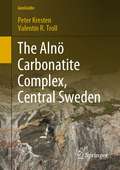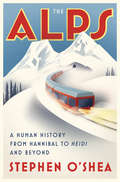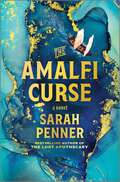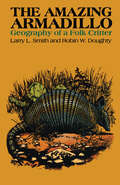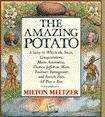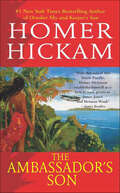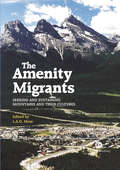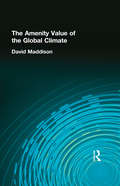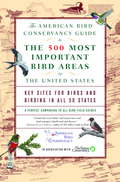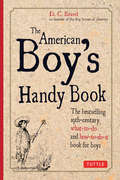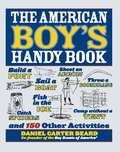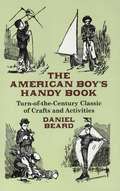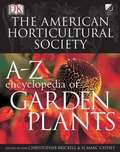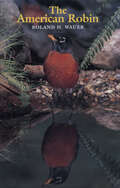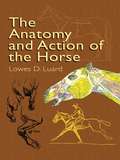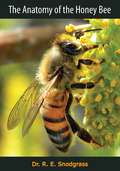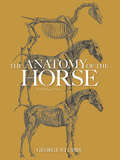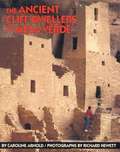- Table View
- List View
The Alnö Carbonatite Complex, Central Sweden (GeoGuide)
by Valentin R. Troll Peter KrestenThis GeoGuide provides an overview of the geology of Alnö, combined with an up-to-date field itinerary. Covering all major geological aspects, it offers an essential summary of Alnö and its intriguing magmatic rocks in a compact form suitable for field excursions and home study alike. As one of the type localities for carbonatite, the late Proterozoic Alnö ring complex has been a crucial site for carbonatite-related research (next to the Fen complex in Norway), and provided one of the earliest test beds for this unique group of igneous rocks. Five geological excursions introduce the visitor to the most rewarding outcrops, including detailed descriptions and a wealth of high-quality colour photographs. The excursions are complemented by a detailed review of the history of scientific investigation on Alnö and, in particular, a catalogue of exotic and common minerals associated with the complex’s carbonatitic and alkaline silicate rocks. Finally, a summary of its trace element and isotope geochemistry as well as a brief outlook on Alnö’s potential as a future source of Rare Earth Elements (REEs) completes the book.
The Alps: A Human History from Hannibal to Heidi and Beyond
by Stephen O'SheaA thrilling blend of contemporary travelogue and historical narrative about the Alps from “a graceful and passionate writer” (Washington Post). For centuries the Alps have seen the march of armies, the flow of pilgrims and Crusaders, the feats of mountaineers, and the dreams of engineers?and some 14 million people live among their peaks today. In The Alps, Stephen O’Shea takes readers up and down these majestic mountains, battling his own fear of heights to journey through a 500-mile arc across France, Italy, Switzerland, Liechtenstein, Germany, Austria, and Slovenia. O’Shea, whose style has been hailed for its “engaging combination of candid first-person travel writing and absorbing historical narrative” (Chicago Sun-Times), whisks readers along more than 2,000 years of Alpine history. As he travels pass-by-pass through the mountains, he tells great stories of those (real and imagined) who have passed before him, from Hannibal to Hitler, Frankenstein’s monster to Sherlock Holmes, Napoleon to Nietzsche, William Tell to James Bond. He explores the circumstances behind Hannibal and his elephants’ famous crossing in 218 BCE; he reveals how the Alps have profoundly influenced culture from Heidi to The Sound of Music; and he visits iconic sites, including the Reichenbach Falls, where Arthur Conan Doyle staged Sherlock Holmes’s death scene with Professor Moriarty; Caporetto, the bloody site of the Italians’ retreat in World War I; and the Eagle’s Nest, Hitler’s aerie of a vacation home. O’Shea delves into Alpine myths and legends, such as the lopsided legs of the dahu, the fictitious goatlike creature of the mountains, and reveals why the beloved St. Bernard dog is so often depicted with a cask hanging below its neck. Throughout, he immerses himself in the communities he visits, engagingly recounting his adventures with contemporary road trippers, watchmakers, salt miners, cable-car operators, and yodelers.
The Amalfi Curse: A Bewitching Tale of Sunken Treasure , Forbidden Love , and Ancient Magic on the Amalfi Coast
by Sarah Penner“Sarah Penner transported me to the sea-swept cliffs of Positano and introduced me to characters I&’ll never forget. A magical read!”—Emilia Hart, New York Times bestselling author of The Sirens. <p> Powerful witchcraft. A hunt for sunken treasure. Forbidden love on the high seas. Beware the Amalfi Curse…Haven Ambrose, a trailblazing nautical archaeologist, has come to the sun-soaked village of Positano to investigate the mysterious shipwrecks along the Amalfi Coast. <p> But Haven is hoping to find more than old artifacts beneath the azure waters; she is secretly on a quest to locate a trove of priceless gemstones her late father spotted on his final dive. Upon Haven’s arrival, strange maelstroms and misfortunes start plaguing the town. Is it nature or something more sinister at work? <p> As Haven searches for her father’s sunken treasure, she begins to unearth a centuries-old tale of ancient sorcery and one woman’s quest to save her lover and her village by using the legendary art of stregheria, a magical ability to harness the ocean. Could this magic be behind Positano’s latest calamities? Haven must unravel the Amalfi Curse before the region is destroyed forever… <p> Against the dazzling backdrop of the Amalfi Coast, this bewitching novel shimmers with mystery, romance and the untamed magic of the sea. <b>New York Times Bestseller</b>
The Amazing Armadillo: Geography of a Folk Critter
by Robin W. Doughty Larry L. Smith&“Chatty, humorous, and sometimes almost hysterically funny . . . Everything, perhaps even more, that you might have wanted to know about armadillos.&” —The Quarterly Review of Biology Perhaps no creature has so fired the imagination of a populace as the armadillo, that most ungainly, awkward, and timid little animal. What is it that sets this quizzical little creature apart from the rest of the animal kingdom? Larry L. Smith and Robin W. Doughty ably answer this question in The Amazing Armadillo: Geography of a Folk Critter. This informative book traces the spread of the nine-banded armadillo from its first notice in South Texas late in the 1840s to its current range east to Florida and north to Missouri. The authors look at the armadillo&’s natural history and habitat as well as the role of humans in promoting its spread, projecting that the animal is increasing in both range and number, continuing its ecological success in areas where habitat and climate are favorable. The book also contributes to a long-standing research theme in geography: the relationship between humans and wildlife. It explores the armadillo&’s value to the medical community in current research in Hansen&’s Disease (leprosy) as well as commercial uses, and abuses, of the armadillo in recent times. Of particular note is the author&’s engaging look at the armadillo as a symbol of popular culture, the efforts now underway to make it a &“totem animal&” symbolizing the easy-going lifestyles of some Sunbelt cities, and the spread of the craze for armadilliana to other urban centers.
The Amazing Potato: A Story in Which the Incas, Conquistadors, Marie Antoinette, Thomas Jefferson, Wars, Famines, Immigrants, and French Fries All Play a Part
by Milton MeltzerIntroduces the history, effects, and current uses of the potato in the world marketplace.
The Amazing Return of the Tree Lobster (Fountas & Pinnell Classroom, Guided Reading Grade 5)
by Sara Latta Loïc DerrienScientists believed that a certain insect had been extinct for decades—until rock climbers off the coast of Australia made a huge discovery. A few of the creatures still remained—living in a bush, at the very edge of extinction. NIMAC-sourced textbook
The Amazon Várzea: The Decade Past and the Decade Ahead
by Christine Padoch Mauro L. Ruffino Miguel Pinedo-Vasquez Eduardo S. BrondízioThis book takes a multi-disciplinary and critical look at what has changed over the last ten years in one of the world's most important and dynamic ecosystems, the Amazon floodplain or várzea. It also looks forward, assessing the trends that will determine the fate of environments and people of the várzea over the next ten years and providing crucial information that is needed to formulate strategies for confronting these looming realities.
The Amazon from an International Law Perspective
by Beatriz GarciaWith a vast river network and rainforests extending over eight South American countries, the Amazon plays a vital role particularly in maintaining biodiversity and terrestrial carbon storage. Due to its ecological characteristics, the Amazon benefits not only those countries but also the international community at large. However, the Amazon forests are being rapidly cleared with a consequent loss of biodiversity and impact on global climate. This book examines whether international law has an impact on the preservation of the Amazon by inquiring into the forms of cooperation that exist among the Amazon countries, and between them and the international community, and to what extent international cooperation can help protect the Amazon. Given the role of this region in maintaining the balance of the global environment, the book examines whether the Amazon should be granted a special legal status and possible implications in terms of international cooperation.
The Ambassador's Son (Josh Thurlow #2)
by Homer HickamIt's 1943 and the Americans and Japanese are fighting a deadly war in the hot, jungle-covered volcanic islands of the South Pacific. The outcome is in doubt and a terrible blow has fallen on American morale. Lieutenant David Armistead, a Marine Corps hero and cousin of the President of the United States, is missing and some say he's gone over to the enemy. Coast Guard Captain Josh Thurlow and his ragtag crew are given the assignment to find Armistead, though not necessarily to bring him back alive. Recruited in the hunt is a tormented and frail PT-boat skipper nicknamed "Shafty" who is also known by another name: John F. Kennedy. When Josh is stranded in the jungles of New Georgia with a mysterious, sensual woman who has a tendency to chop off men's heads, it's up to Kennedy to come to the rescue and complete the mission. But to procure a gunboat, he first has to play high-stakes poker with a young naval supply officer called Nick who happens to be the best gambler in the South Pacific. Nick has another name, too: Richard M. Nixon. Based solidly on historical fact with echoes of James Michener, The Ambassador'sSon is a thrilling tale of the South Pacific and adventure fiction at its finest.
The Amenity Migrants: Seeking and Sustaining Mountains and Their Cultures
by Laurence A. G. MossPlaces with perceived high environmental quality and distinctive culture are globally attracting amenity migrants. Today this societal driving force is particularly manifest in mountain areas, and while beneficial for both the new comers and locals, is also threatening highland ecologies and their human communities. This book describes and analyzes the challenges and opportunities of amenity migration and its management, and offers related recommendations. The book's chapters cover the subject through case studies at international, regional and local levels, along with overarching themes such as environmental sustainability and equity, mountain recreation users, housing, and spiritual motivation. A crucial issue addressed is the relationship of amenity migration to tourism, and migration motivated by economic gain. The introduction and concluding chapters bring all of the information and analyses together strategically, summarizing in a manner of theoretical and practical value for both academics and practitioners.
The Amenity Value of the Global Climate
by David MaddisonThis text develops and applies a far-reaching account of the economic value of climate, derived from its amenity value or the benefits which a particular climate provides to the people of that region or country. As climate change moves higher on the economic and political agendas, reliable measures of the benefits and costs of specific climates and changes to them become ever-more critical. Detailed studies of a range of countries including Britain, the US, India and Russia, show that the mobility of the population is crucial. When individuals are able to move, the amenity value of the climate is reflected in land prices and wage rates. Without mobility, amenity values emerge in patterns of purchasing, either to compensate for the disadvantages of the climate or to make best use of it. Indices are generated for the cost of living as a function of climate variables, and optimal climates are identified to determine who wins and who loses from climate change.
The American Bird Conservancy Guide to the 500 Most Important Bird Areas in the United States
by American Bird ConservancyThe American Bird Conservancy Guide to the 500 Most Important Bird Areas in the United States offers both bird enthusiasts and conservationists specialized information never before compiled in a single comprehensive volume. This expert resource organizes the United States into 36 ornithologically distinct bird regions, then identifies and describes the 500 sites within these regions. Each site entry includes ornithological highlights, ownership information, a description of habitats and land use, a guide to which species one can expect to find, conservation issues, and visitor information. Full-color maps and illustrations throughout, along with a thorough index, make this book as useful as it is unique, an essential addition to the bird lover’s library.
The American Boy's Handy Book
by Daniel C. BeardLong before a "dangerous" book was all the rage there was The American Boy's Handy Book by Daniel Beard, a beloved classic for generations of youngsters. Specially designed to provide loads of ideas for adventures and games both indoors and outdoors during each season of the year, The American Boy's Handy Book was originally published in 1882 and became an instant bestseller.Now, Tuttle Publishing is bringing this much-loved book back for a new generation of boys to enjoy. If you're not too young to fly a kite or too old to enjoy a day fishing, The American Boy's Handy Book is chock full of fun activities intended just for you! There's something for every day of the year: making an aquarium, rigging and sailing small boats, camping without a tent, making a cornstalk fiddle, trapping, building a snow fort, and of course tons of other games and crafts, too.Daniel Beard firmly believed in letting boys make their own playthings, encouraging them to value their own hard work and gain the skills needed throughout life to successfully invent, construct and dream. In this world of instant gratification with ever-younger generations coveting the ubiquitous cell phones, computers and iPods, it seems as though the imagination and sense of adventure that permeated our country's past have all but disappeared. Welcome back the joys of childhood with The American Boy's Handy Book, and prepare to make old favorites new again!
The American Boy's Handy Book
by Daniel Carter BeardDARING ACTIVITIES.<P> OUTDOOR SKILLS.<P> WILD-EYED ADVENTURES.<P> In 1882, Daniel Beard, co-founder of the Boy Scouts of America®, wrote the ultimate adventure guide, The American Boy’s Handy Book. Now the author’s most exciting projects, excursions and challenges are presented bigger and better than ever in this newly designed large hardcover edition. Here are the author’s original descriptions and personal illustrations of timeless adventures that combine good fun and innocent mischief while teaching boys how to be constructive, creative and courageous and become:<P> •The Boy Inventor<P> •The Boy Gamer<P> •The Boy Hunter<P> •The Boy Camper<P> •The Boy Fisherman<P> •The Boy Naturalist<P> •The Boy Boater<P>
The American Boy's Handy Book: Turn-of-the-Century Classic of Crafts and Activities
by Daniel BeardAs timely as it is timeless, this instructive book has captured the interest and imagination of boys for well over a century. Chapters on kite flying and fishing, rigging and sailing small boats, camping out without a tent, knot-tying for mountain climbing and other activities, as well as training dogs, raising wild birds, and other projects will appeal as much to today's youngsters as they did to children in the late 1800s. This classic includes scores of projects that will keep children occupied all year long ― from sculpting snowmen and making sleds to stocking aquariums and performing puppet shows. Many of these enterprises have also been known to compete effectively with TV and video games! Best of all, the projects have the power to inspire the imagination and help youngsters master new skills and experience the satisfaction of personal accomplishment.
The American Experience in Environmental Protection
by Lisa NewtonThis book tracks the growth of environmental awareness and conservation in the United States through the major trends of the 20th century, and establishes a philosophical ground for protection of the environment. It records a major cultural shift in the thinking of this nation, and provides guidelines for its continuation.
The American Horticultural Society A to Z Encyclopedia of Garden Plants (Revised American Edition)
by Christopher Brickell H. Marc CatheyAmerican Horticultural Society A to Z Encyclopedia of Garden Plants is a comprehensive, detailed, and illustrated alphabetical guide to some 15,000 ornamental plants and an essential reference for all gardeners and horticulturists. Easy to Use Plants are arranged alphabetically by their botanical names for fast, straightforward access, and previous names and common names appear as cross-references throughout the main text.
The American Robin (Corrie Herring Hooks Series)
by Roland H. WauerThe American Robin is North America's most widespread songbird, with a range extending from Alaska, Canada, and Newfoundland to the highlands of Mexico and Guatemala. Its ruddy red breast and cheerful song have also made it one of our most beloved birds—as American as apple pie, as familiar a harbinger of spring as the first daffodil. Connecticut, Michigan, and Wisconsin have chosen the American Robin as their state bird, while a pair of robins grace the Canadian two dollar bill. In this book, Roland Wauer offers a complete natural history of the American Robin for a popular audience. Combining his own observations as a field naturalist with data gleaned from the scientific literature, he describes the American Robin from every angle—appearance and biology, distribution, behavior, life cycle, and enemies and threats. In addition, he explores the legends and lore surrounding robins and offers suggestions for attracting them to your yard.
The American Steppes: The Unexpected Russian Roots of Great Plains Agriculture, 1870s–1930s (Studies in Environment and History)
by David MoonBeginning in the 1870s, migrant groups from Russia's steppes settled in the similar environment of the Great Plains. Many were Mennonites. They brought plants, in particular grain and fodder crops, trees and shrubs, as well as weeds. Following their example, and drawing on the expertise of émigré Russian-Jewish scientists, the US Department of Agriculture introduced more plants, agricultural sciences, especially soil science; and methods of planting trees to shelter the land from the wind. By the 1930s, many of the grain varieties in the Great Plains had been imported from the steppes. The fertile soil was classified using the Russian term 'chernozem.' The US Forest Service was planting shelterbelts using techniques pioneered in the steppes. And, tumbling across the plains was an invasive weed from the steppes: tumbleweed. Based on archival research in the United States, Russia, Ukraine, and Kazakhstan, this book explores the unexpected Russian roots of Great Plains agriculture.
The Amoeba Sisters' Cartoon Guide to Biology
by Brianna Rapini Sarina Peterson24 Major Biology Topics You Should KnowExplore the wonders of biology inside and outside of the classroom with The Amoeba Sisters’ Cartoon Guide to Biology. Science facts made easy. From the dynamic sister duo behind the beloved Amoeba Sisters YouTube channel, this visual learning book features 24 major educational concepts commonly taught in life sciences courses. Designed to alleviate the intimidation often associated with complex science concepts, this guide employs amusing mnemonics, real-world examples, and light-hearted humorous anecdotes to make biology topics more approachable and relatable.Designed for anyone studying biology. Whether you’re a high school student, a college scholar, or a curious biology enthusiast, this book ensures that learning biology remains engaging and accessible for all ages to enjoy. This book tackles topics students often find difficult, such as cell transport, cellular respiration, protein synthesis, DNA replication, mitosis, and meiosis, with each chapter addressing stumbling blocks they may encounter in the classroom or during study prep. Whether used as an introduction to a concept or to recap a lesson, this book also makes a great supplement to your biology textbook as a classroom set.Pairs well with any biology course.Illustrations, diagrams, and cartoons break down complex biology conceptsShort chapters provide a biology foundation in the style of Amoeba Sisters videosUseful for teachers and students, includes objectives at end of each chapter to help with test preparationGlossary of over 250 biology vocabulary words with easy-to-understand, brief definitionsSo if you enjoy teen and kid science books such as Physics for Curious Kids, Awesome Facts That Will Make You Look Super Smart, or Noah’s Fascinating World of STEAM Experiments, then you’ll love The Amoeba Sisters’ Cartoon Guide to Biology.
The Anasazi: Prehistoric People of the Four Corners Region
by J. Richard AmblerAmbler explores the Four Corners of Colorado, Utah, Arizona and New Mexico. Weaving together its geological, ecological and human histories, he presents a unique portrait of this ruggedly beautiful landscape that goes beyond mere description to give readers a true sense of the land in all its richness. Here are rock croppings that are 2 billion years old and broad desert valleys where rivers of lava cooled to form floors of solid rock. Here ancient hunter-gatherers stalked the woolly mammoth, four-story pueblos were carved by the Anasazi from sheer stone cliffs and an ancient midnight Holy Week ceremony is still practiced in a modern Spanish village. Providing a fresh perspective on a region currently enjoying an upwelling of interest, Four Corners is a study of one of the world's great wonders -- compelling reading for all science, nature, anthropology and travel aficionados.
The Anatomy and Action of the Horse
by Lowes D. LuardThis easy-to-read text explains the horse as a machine designed for movement. Using different colors in his drawings, the author not only describes with clarity the horse's skeleton and the functions of various muscles, but also creates images that have the power to suggest movement and stress. More than 75 illustrations include accurate diagrams and color illustrations fo the horse's anatomy, as well as meticulously rendered sketches of the entire animal.Of value to students and teachers of art, this book will also appeal to horse lovers who want a deeper understanding -- without having to examine the anatomical complexities of the subject -- of why this animal is capable of moving with such grace and speed.
The Anatomy of the Honey Bee
by R. E. SnodgrassThis is not just a technical reference book on honey bee anatomy. It is far more, it is essentially a treatise on entomology, using one species as an example, and including a discussion of the fundamentals of embryology, development, and metamorphosis as well as anatomy. The subject of each chapter is approached from the broadest evolutionary point of view, and its horizon includes all the arthropods and beyond, so that the bee really typifies animal life in general.
The Anatomy of the Horse
by George StubbsGeorge Stubbs (1724-1806), an English artist famous for his portraits of thoroughbred race horses and for other animal paintings, was also the author of the illustrations and text of The Anatomy of the Horse, one of the truly remarkable anatomical studies of its subject. First published in 1766, Stubbs' work was based on numerous dissections, a practice far from generally accepted in his century. Stubbs' horses, shown in this edition on 36 large plates, are memorable for their uncanny life-like quality, nobility, and extreme anatomical precision. In this systematic study, Stubbs depicts the horse in three positions - side, front, and back. He first presents the skeleton alone in each of these three positions, then devotes to each position five studies of layers of muscles, fascias, ligaments, nerves, arteries, veins, glands, and cartilages. Accompanying each of these eighteen etchings is a schematic etched outline with lettered parts that are keyed to the identifying text. The text is given both in Stubbs' original version and in a modernized version prepared in the Thirties by J. C. McCunn and C. W. Ottaway.
The Ancient Cliff Dwellers of Mesa Verde
by Caroline ArnoldDiscusses the Native Americans known as the Anasazi, who migrated to southwestern Colorado in the first century A.D. and mysteriously disappeared in 1300 A.D. after constructing extensive dwellings in the cliffs of the steep canyon walls. For children.
